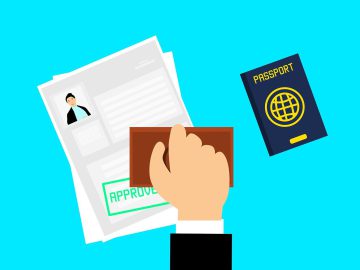If you’re aiming to increase earnings from your online content, implementing an affiliate marketing strategy may be a good idea.
Amazon hosts one of the most popular affiliate marketing programs, occupying nearly half of the entire affiliate network market. With more than 900,000 affiliate partners, the Amazon Associates program helps content creators, publishers, and bloggers monetize their traffic.
Research shows that Amazon is the first destination for most shoppers. With such a strong brand presence, sending people from your content to Amazon products could result in higher conversion rates.
Ahead, learn how to become an Amazon Associate, featuring tips, steps, and real examples.
What is the Amazon Associates program?
The Amazon Associates program is one of the world’s largest affiliate marketing programs. Like the Shopify Affiliate Program, it allows creators, publishers, and bloggers to monetize web traffic by promoting Amazon products in their content.
After acceptance to this free program, you’ll be able to generate affiliate links to promote to your audience. When someone clicks an affiliate link and buys a product, you’ll receive a commission.
Amazon commissions range from 1% to 20% depending on the product category.
Amazon has few requirements on how affiliate links are promoted, meaning they can be used by a variety of creators and businesses. Amazon Associates include YouTubers, bloggers, and TikTok influencers—as well as online stores and product review websites.
How much do Amazon affiliates make?
Amazon affiliate program earnings depend on the commission rates of the products that partners choose to promote, and the volume of clicks that affiliates can generate from relevant web traffic.
Amazon affiliates can make as little as a hundred dollars a month or as much as six figures per year.
Hugo Guerreiro, founder of men’s fashion affiliate website The Men Hero, shares his site’s initial earnings: “I started my men’s lifestyle blog at the end of April of 2021. In November, we made $963.69 from Amazon Associates, and the number keeps growing.”
According to ZipRecruiter, the national average salary for an Amazon affiliate is $77,893 per year. Top earners make up to $126,500, while the lowest 13% earn between $35,000 and $43,499.
Amazon affiliate program requirements
To become a partner in the Amazon Associates program, you must meet the program’s rules and requirements. The main participation requirements are outlined in Amazon’s program policies.
Once you’ve signed up, Amazon will also review your initial activity and reject your account if you don’t meet its performance requirements.
Here are the main Amazon Associate requirements to keep in mind:
Platform requirements
- Websites must be public and contain accurate, up-to-date information.
- Mobile apps must meet Amazon’s policy standards.
- Supported social media channels are Facebook, Instagram, Twitter, YouTube, TikTok, and Twitch.
Affiliate content rules
- Your website or social channel must contain recent content (at least ten posts within the last 60 days).
- All affiliate links must include correctly tagged identifiers.
- Your content must be original.
Minimum performance standards
- You must make at least three qualified sales within your first 180 days as an affiliate.
- Social media affiliates must have at least 500 followers.
Common reasons for rejection
- Insufficient or unoriginal content.
- Incorrect usage of affiliate tagged links.
- Non-compliant content or practices.
Becoming an Amazon affiliate: pros and cons
While there are a lot of great reasons to join the Amazon affiliate program, it’s not for everyone. Let’s look at the pros and cons to decide whether Amazon affiliate marketing is right for you.
Pros
- Amazon links are trustworthy and well known.
- You’ll have access to a global marketplace.
- You can choose to be paid by direct deposit, check, or Amazon gift cards.
- There are millions of Amazon products for you to promote.
- Amazon affiliate links can be promoted on ecommerce stores, meaning you can take advantage of Shopify’s tools and apps.
Cons
- Compared to some affiliate programs, Amazon’s cookie window is short. Referrals must add items to their basket within 24 hours of clicking your link for you to be eligible to receive a commission. (Note: referrals can checkout at a later date.)
- You can’t promote products via email.
- Commission rates are low compared to direct brand programs.
For some, access to a huge worldwide market with virtually unlimited products is enough reason to sign up. But for others, not being able to promote affiliate links in emails can be a deal-breaker (especially those with a large email list already).
If earning money as an Amazon Associate sounds good to you, read the step-by-step tutorial below.
How to become an Amazon affiliate
- Go to the Amazon Associates center and click the Signup button
- Fill in your information
- Add your website, mobile app, or YouTube channel
- Set up your profile
- Explain how you drive traffic to your site or app
- Add your tax and payment information
- Integrate with Shopify using the Amazon Associate Connector app
Because most of the review process happens after signup, joining the Amazon affiliate program is easy.
Before you head to Amazon, make sure your website or content channel is live, public, and already populated with content. From there, you can apply for an Amazon Associates account.
1. Go to the Amazon Associates center and click the Sign up button
To start the process of signing up for the Amazon affiliates program, you’ll be asked to either sign in with an existing Amazon account or to create a new one. If you only have a personal account, it would be best to create a new one to separate your business. However, if you have a phone number linked to your personal account (and no business phone number), you won’t be able to create a new account.
2. Fill in your information
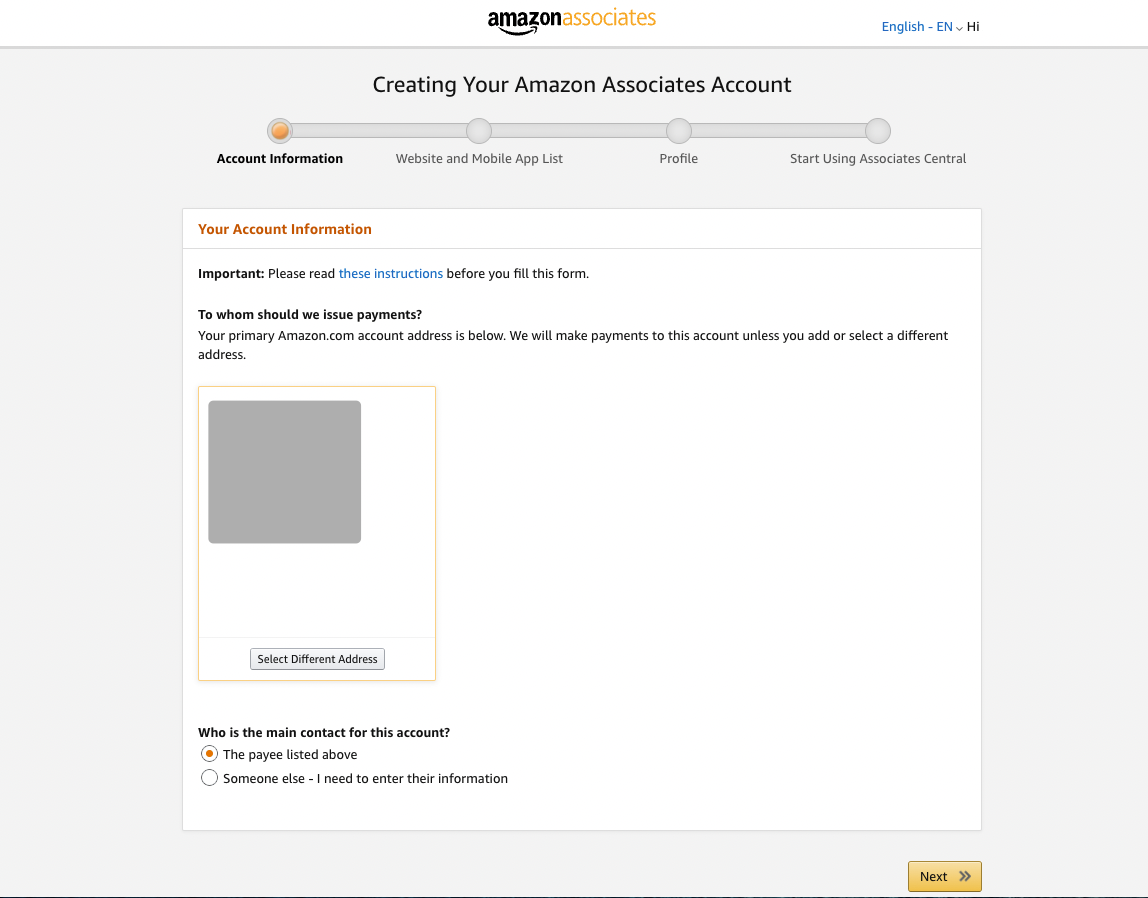
Next, you’ll need to fill in your affiliate account information for Amazon to be able to pay you your earnings correctly.
3. Add your website, mobile app, or YouTube channel
You can add up to 50 websites or mobile apps. If you have more than one digital home, feel free to add them. These are all places where you could place an affiliate link.
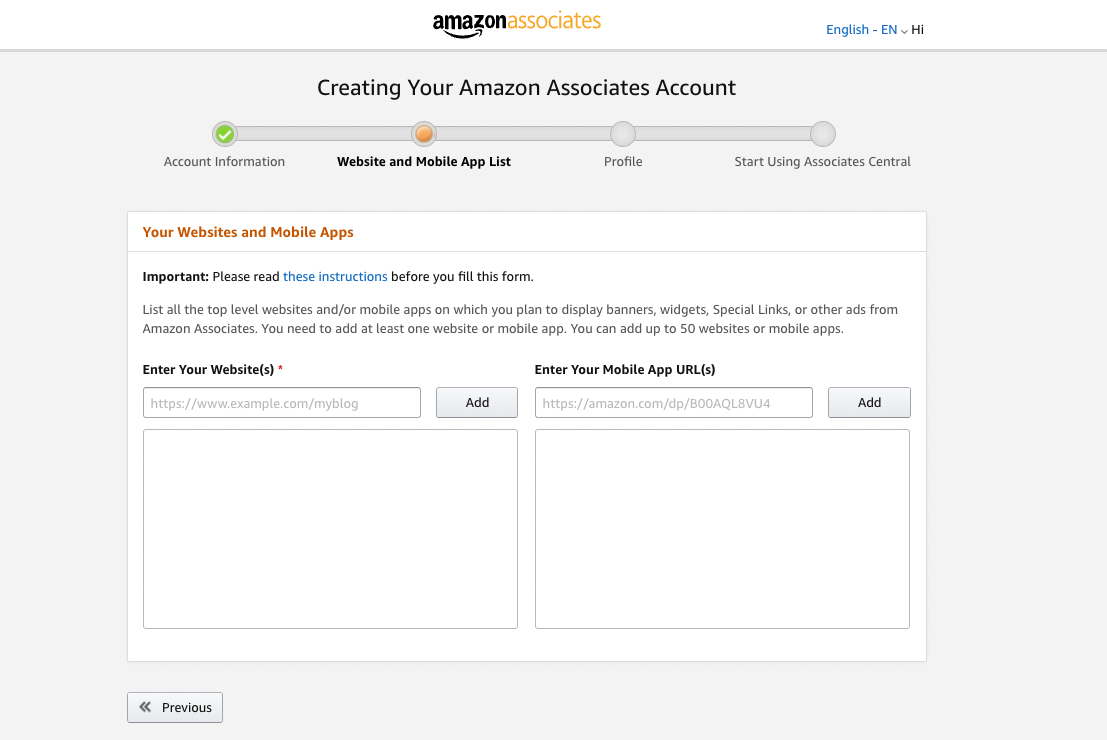
Once you’ve added a website and hit the Next button that appears, you’ll also be asked if your site or app is targeted toward children under 13 (these sites aren’t eligible for the program).
4. Set up your profile
This section asks you to fill out the information about your website (as well as your preferred store ID, which will normally be your business name). Amazon wants to know what your website is about and what type of products you’ll build affiliate links for.
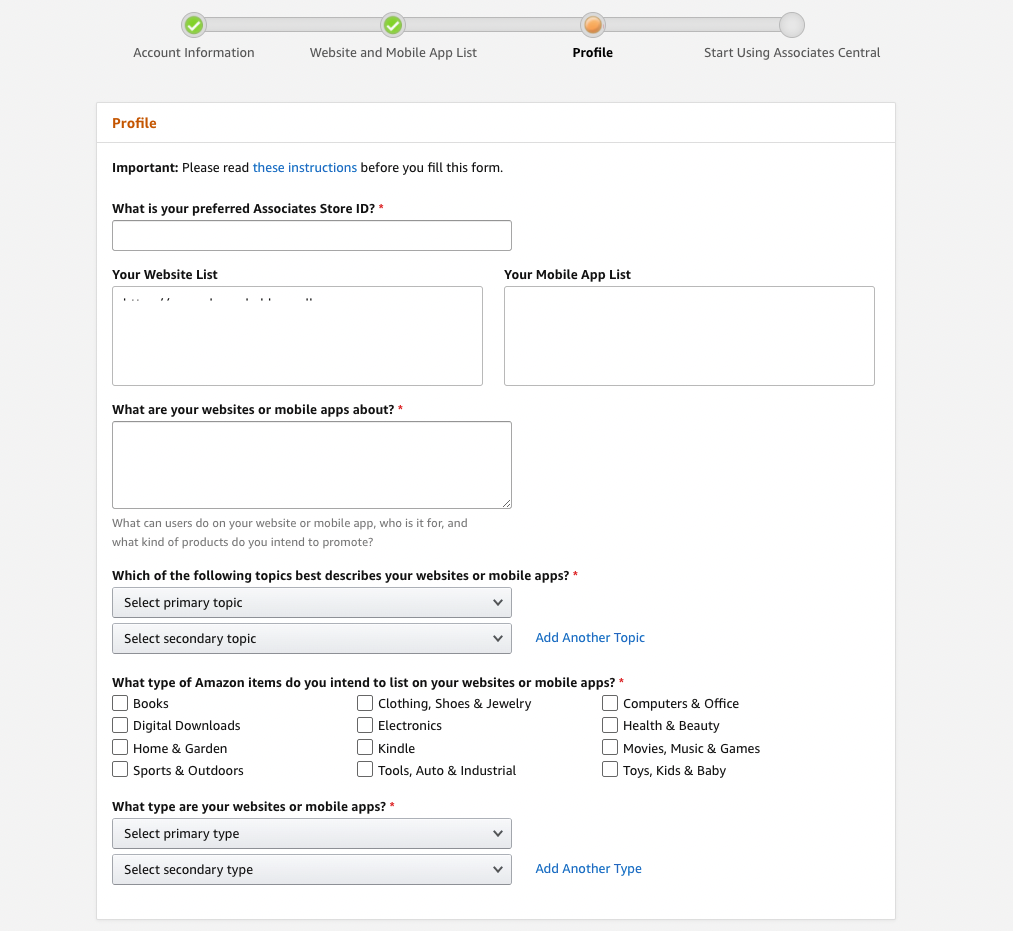
5. Explain how you drive traffic to your site or app
The next section of the Amazon affiliate account process asks you to explain how you drive traffic to your site (you can choose more than one option). You’ll also need to share how your website or app currently generates income, how you build affiliate links, your total unique visitors, and why you want to join the program.
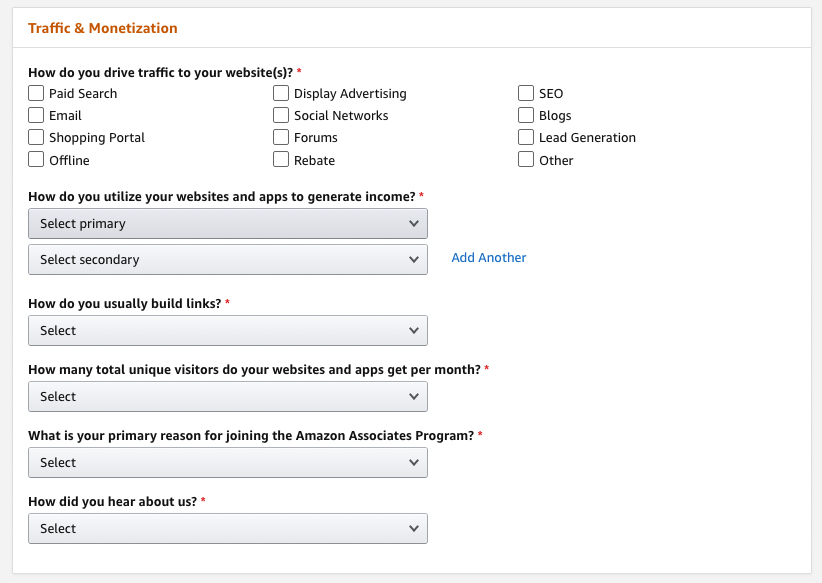
After that, you’ll need to complete the security CAPTCHA and agree to the operating agreement.
6. Add your tax and payment information
Once you’ve completed the application, you’ll be prompted to add your payment and tax information, though you can choose to do it another time. From there you’ll be able to start using Associates Central to create affiliate links.
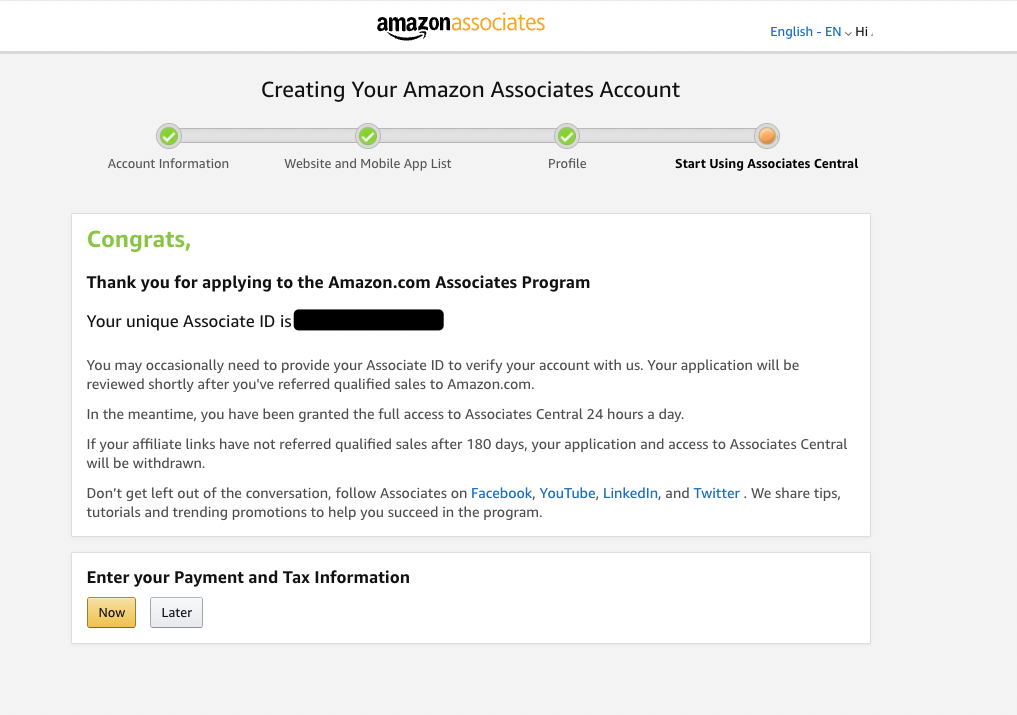
7. Integrate with Shopify using a connector app
If your website runs on Shopify, use a marketplace connector app to quickly import Amazon products into your Shopify store.
This is a fast way to create a high-quality Amazon affiliate website. After linking your Amazon Associates account, you can import specific products using the product URL.
Once you’ve added the product through the connector app, it will be displayed in your Shopify store, where people can click through to make a purchase.
Affiliate marketing tips to boost income
To make the Amazon affiliate program work, you’ll need to strategize.
Here are some tips and strategies on boosting your affiliate income and building a stream of passive income after you’ve set up your Amazon affiliate account.
Find a niche
As with any brand strategy, establishing yourself in a niche is a good way to target a specific segment of customers. A niche is a segment of the larger market defined by its own needs and knowledge. It becomes your specialty as an affiliate marketer.
“Dive into your niche and really know the ins and outs of it to be able to solve the problem someone might have with a particular product,” advises Arun Grewal, founder of affiliate niche site Coffee Brewing Pro. “Affiliate marketing is about adding your own insight and perspective and becoming an authority for a particular niche or problem.”
Focus on a particular product category you’re genuinely interested in. That way, it’ll be easier to stay engaged with building the business. For example, Amazon Associate Elise Dopson founded Sprocker Lovers, a pet care site for advice, tips, and product reviews.
According to her, “Amazon Associates has been a critical factor for monetizing blog traffic and providing readers with reputable, quality product options. Elise includes Amazon affiliate links in her niche blog posts, directing readers to the marketplace to purchase a variety of pet-related products.
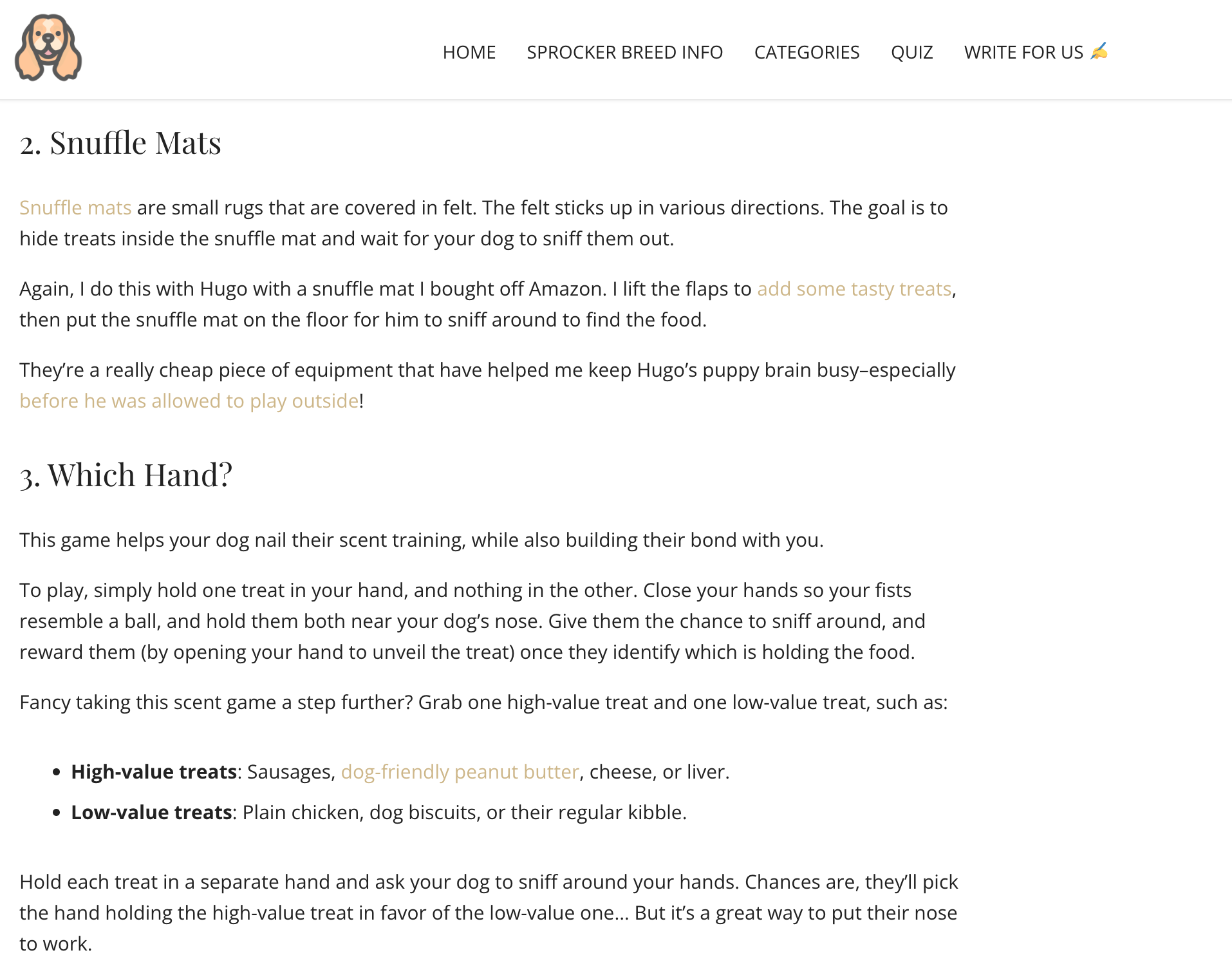
Sprockerlovers.com
So, how can you find your own niche? Consider the following criteria:
- It’s a topic you’re interested in. Good affiliate marketers become experts in their industry over time. Stay on top of trends, take part in events, and be constantly learning.
- You can solve the niche’s problems. People will follow you because they enjoy your insight and you add value by helping them solve problems.
- The niche is profitable. Run a Google Trends search to see how popular your niche is. Look at market research reports and check how often people search for your niche topics. This can signal whether or not people are ready to buy.
Create original content on different platforms
As an online entrepreneur, you already know the value of original content. It helps you stand out, build credibility, and foster trust with followers—all things you need for successful affiliate marketing.
But creating original content isn’t sufficient. You also need to distribute content across multiple platforms, considering that omnichannel customers shop 1.7 times more, and spend more than single channel customers.
Let’s look at the socially responsible company Package Free, for example. Package Free is the storefront for the blog and YouTube channel Trash is for Tossers, a zero- to low-waste lifestyle brand.
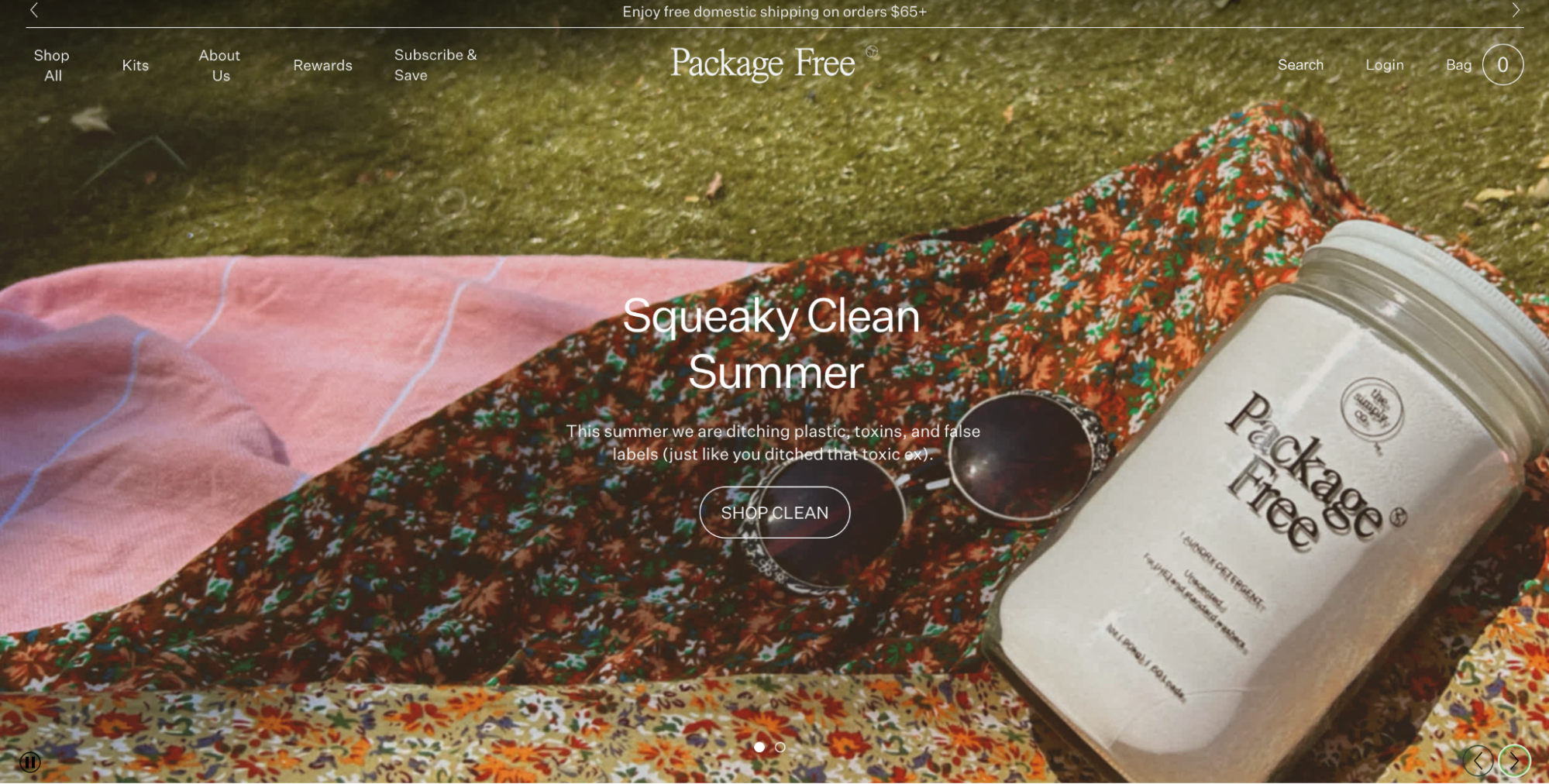
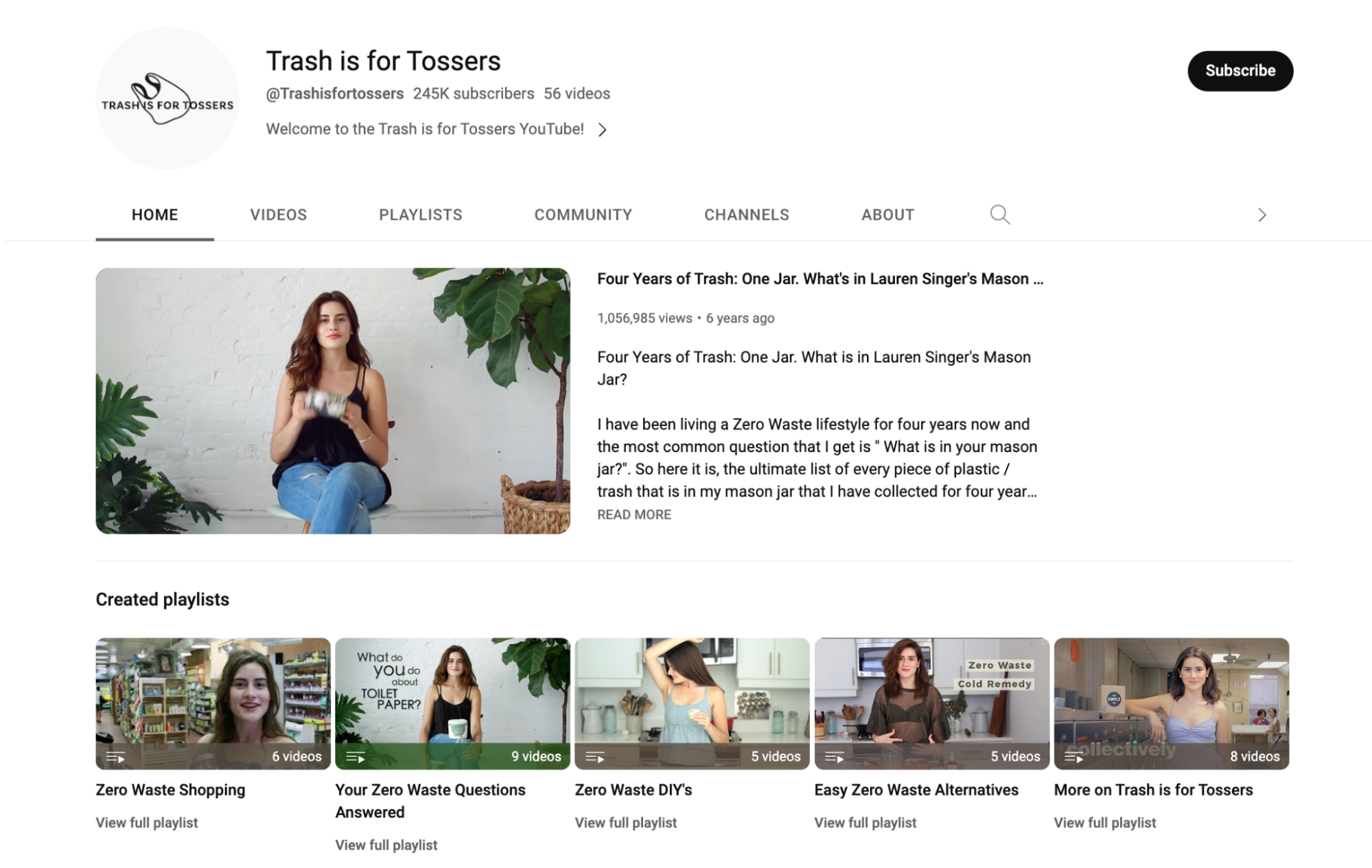
The YouTube channel is full of content designed to help people live a more sustainable lifestyle. By creating this content and showing expertise, they’re able to attract the type of people who are likely to trust and eventually buy from them. That way, when they place Amazon Affiliate links in the content, they seem trustworthy.
Another reason to create original content elsewhere is to target long-tail keywords in multiple formats. In the image above, you can see some of those long-tail phrases on playlists such as “easy zero waste alternatives” and “zero waste shopping.”
Keep in mind that building a content library is a long-term process. Like any affiliate marketing strategy, time and dedication will lead to significant results down the road.
Invest in SEO
If you want people to come to your website through Google or any other search engine, you’ll also need to think about search engine optimization (SEO). Making sure your website is optimized for search engines helps you appear in search results.
However, SEO isn’t about keyword stuffing. So how do you make sure your website is optimized for search engines? You create webpages or include content that helps them understand your website better.
Product reviews
Including product reviews serves a dual purpose. They help create social proof for potential customers as well as bolster your SEO. This is because they keep your content fresh and up to date.
An affiliate that posts honest, unbiased product reviews, either their own or that of customers, can build loyalty with followers—and turn reviews into conversions. In fact, according to one McKinsey study, products with a star rating of 3.5 or higher made up 95% of products sold.
“Share your experience with the product to customers and always give the best and the worst points about it with examples,” says Guerreiro of The Men Hero. “Customers want to know what you like about it and what you didn’t, because they have a particular fear of buying the product that can disappear after reading your experience, making them purchase it faster.
You can also create buying and gift guides for products you recommend as an affiliate. Affiliate marketers frequently create gift guides as part of their content strategy and post recommendations with affiliate links like Amazon.
If a reader wants to make a purchase, they can click the link and buy it on Amazon. For example, The Everyday Farmhouse is an Amazon affiliate with a homesteading gift guide.

Whether created as blog posts or dedicated web pages, product comparisons are also a great way to boost SEO, since data shows 60% of customers start their product search on Amazon. Offering comparisons to similar products helps customers with their research.
Homepage
It can be easy to forget about SEO for your homepage. Some easy ways to optimize your homepage include having your target keyword in your homepage title, optimizing the page meta description, making it mobile-friendly, adding SSL, and keeping the loading speed fast.
“The best way to drive organic traffic to your blog and generate a sufficient amount of revenue is to combine high-quality content with SEO,” says Nicholas Martin, founder of the affiliate site Pest Control Hacks. “If you invest in SEO, you will gain more exposure and drive affiliate sales naturally.”
These are just a few areas you can look at for SEO, but another way to get to the top of Google is to build a blog. When you post high-quality blog content consistently, you build credibility about a specific topic, which can help you rank higher for related keywords.
Start a blog
Building a blog is similar to creating content on other platforms. The main reason to post content on your blog is to help build your subject matter expertise, help with SEO, and direct people to your products.
Resources:
Earn more with Amazon today
Entering the world of affiliate marketing is easy and free with the help of the Amazon Associates program. All it takes is a website, app, or YouTube channel, signing up to Amazon, and creating content that you can include affiliate links in.
However, you can take it a step further by connecting your Amazon affiliate account to your Shopify store using the Amazon Associate Connector app—allowing you to display full Amazon product listings and affiliate links on your storefront, but with your store branding.
Getting started with Amazon Associates is a quick way to make money online. Once you place your first affiliate link, you’re ready to start earning passive income by recommending great products to your loyal followers.
Amazon affiliate program FAQ
How do I become an affiliate marketer for Amazon?
You can join the Amazon affiliate marketing program by following these steps:
1. Head to the Amazon Associates website and click Sign Up.
2. Enter the required information.
3. Add your website, YouTube channel, or mobile app.
4. Set up your affiliate profile.
5. Show how you drive traffic to your site.
6. Add tax and payment information.
7. Use the Amazon Affiliate Connector app for Shopify.
8. Place your Amazon affiliate links in your content and wait to get paid.
What are the benefits of becoming an Amazon affiliate?
Becoming an Amazon affiliate comes with a number of benefits including:
- Amazon is the largest online marketplace in the world.
- Consumers trust buying products through an Amazon affiliate link.
- You can get paid by direct deposit, check, or Amazon gift cards.
- There are millions of products to choose from.
- You can connect your Amazon Affiliates account to a Shopify store.
How much do Amazon affiliates make?
According to ZipRecruiter, the average salary for an Amazon affiliate is $77,983 per year. The top 3% of earners in the Amazon affiliate program make between $110,500 and $126,500, while the lowest Amazon Associates 13% earn between $35,000 and $43,499.




